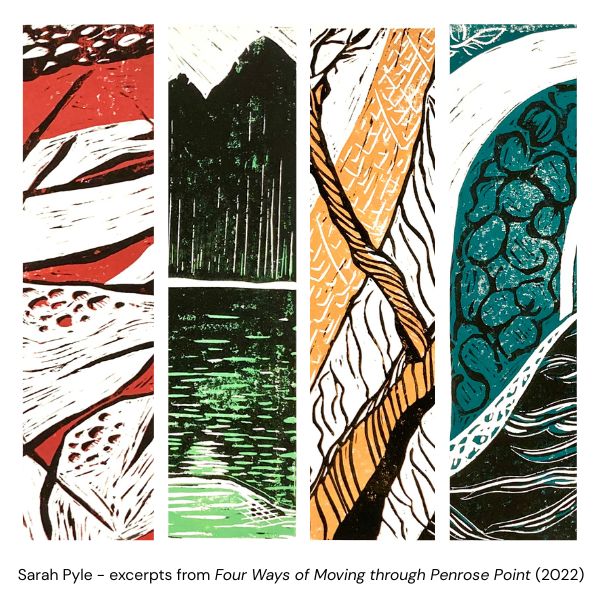Racer Session #565 | Flicker Duo | Sunday May 21st, 2023 at 7pm
This Sunday at Racer Sessions we’ll be presenting Flicker Duo, a collaboration between Sarah Pyle, flute, and Janna Webbon, violin, that creates incandescent moments that evolve between sound and noise. Based in Western Washington, they build improvised sonic worlds inspired by visual art and the rich ecosystems of the Pacific Northwest. Janna and Sarah have both been wonderful presences at Racer Sessions in the past and we’re excited to host them as they share a recent project. Four Ways of Moving Through Penrose Point.
Four Ways of Moving through Penrose Point, composed by Sarah Pyle, is a 20-minute electroacoustic work played from a limited run of linoleum print graphic scores. Each score represents a notable feature of Penrose Point State Park, located in South Puget Sound, and invites the performers to explore movement through the lush yet harsh winter landscape of the Point.
Below you can find dialogue between Janna and Sarah, as they discuss the first movement of Penrose. We hope you’ll join us at the session this Sunday at 7pm! A reminder that we only have two more sessions left before we take a little summer break!
—
Graphic score for Movement I of Sarah Pyle’s Four Ways of Moving through Penrose Point
J: First we’re looking at ‘Fractures at Low Tide.’ I’ve noticed that the word “fractures,” the pulling apart, breaking, seeing between the cracks, happens at low tide because that’s where that space between water and land is. The tide moves along so the line keeps moving. Then I see pebbles and the sand pulling apart when it dries. The red makes me think of a sunset, which is another kind of fracturing between day and night.
S: I like that! How would you interpret that musically?
J: I want to leave some space between things. And see where instruments have a failing point. How would you interpret that?
S: This movement I think is the easiest for me to interpret literally as a graphic score. The dark lines running up and down and across, I almost read on an x y axis as far as pitch and duration goes, and I was making those really bold strokes of sound. The more pebbly textures under the lines, I was doing key clicks, or some kind of tiny percussive effort. This movement for me is really textural and easier to interpret.
J: Yeah I guess the whole piece is about moving through things, so you’re thinking about what it’s like to move across the low tide with more rocks exposed.
S: And that spot was very slippery! I almost fell a few times. Because it was an exposed rock face, with these gouges in it that held little pools of water, which you can see in the red triangles. So walking across it was really treacherous.
J: It’s also a barrier for you to get places. So you can imagine yourself traveling along that line, but you can also imagine that the lines are barriers between different areas. Those tidepools are isolated temporarily on their own. There are bold things but I also feel like this movement is a little quieter.
S: That’s really interesting. I think of it almost as an aggressive movement. The lines are really sharp and the color is really bold. I see animals in the shapes, and it feels really wild. Can you talk more about how you’re interpreting it as quiet? Because I really like that.
J: When you pointed out the little tidepools between the gouges, I think of all the little tiny life forms doing their creepy-crawly things. A little anemone splashing around can’t make a big sound. It’s not quiet in the sense that it’s calm, more that it’s tiny.
—


